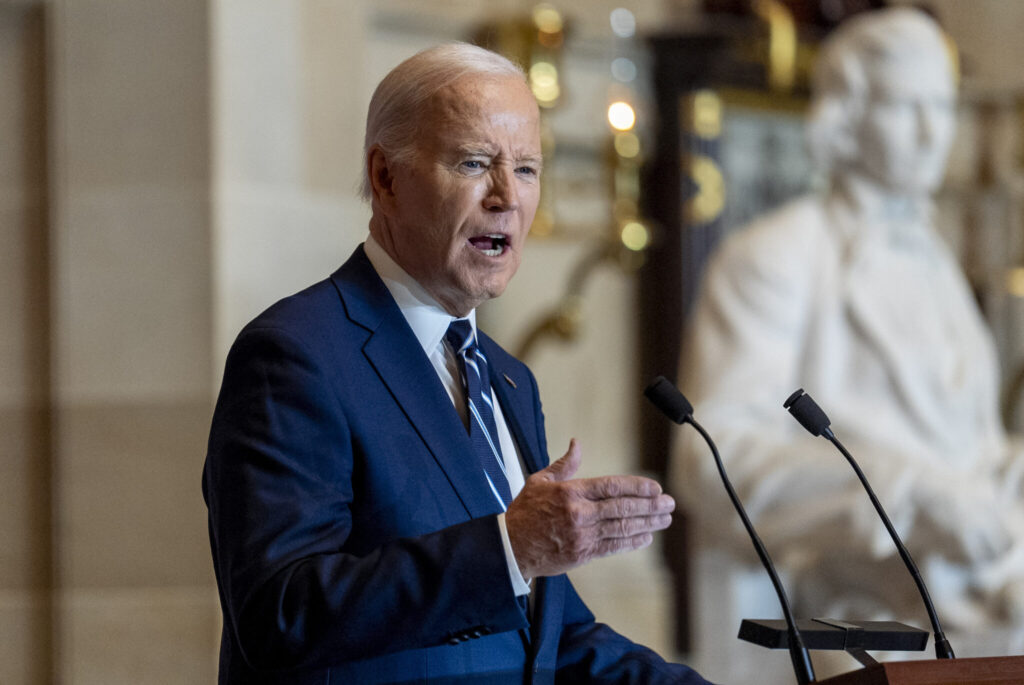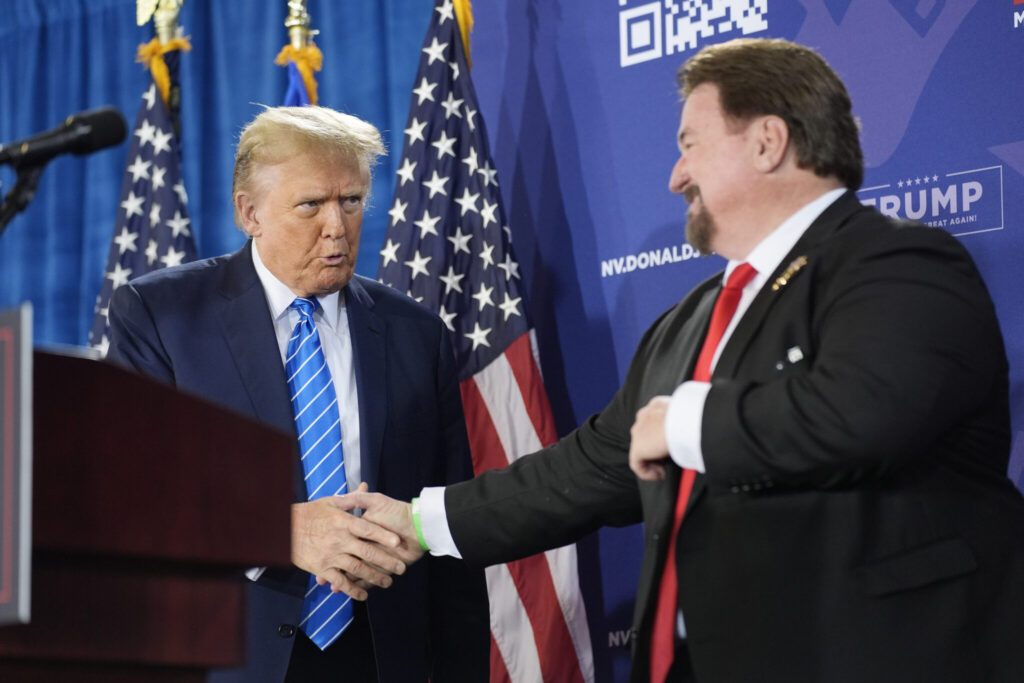Nevada again holds the coveted first-in-the-West slot in the presidential campaign calendar, but this year’s showdown in the Silver State won’t look like it did in previous years. State lawmakers opted to move away from the Iowa-style presidential caucuses that Nevada had held for years in favor of a traditional, state-run primary next Tuesday. The state GOP opposed the plan and opted to hold caucuses on Feb. 8 to allocate delegates. The party also barred candidates running in the primary from running in the caucuses, forcing them to choose one event over the other. Donald Trump is competing in the caucuses, in which all 26 delegates will be awarded, while Nikki Haley opted to stay on the non-binding primary ballot. She’s the only active major candidate on the ballot, but her biggest opponent on Tuesday might be the “None of these candidates” option that some Trump supporters might use to send her a message ahead of the South Carolina primary on Feb. 24. In the Democratic primary, President Joe Biden faces author Marianne Williamson and a handful of relatively unknown challengers.
Here’s a look at what to expect in Nevada:
Quick Read
- Nevada Primary Changes: Nevada shifts from caucuses to a state-run primary for the presidential election, with GOP holding separate caucuses due to opposition to the change.
- Caucus vs. Primary Participation: Trump competes in the GOP caucuses, while Haley remains on the primary ballot, potentially challenged by the “None of these candidates” option.
- Democratic Primary Candidates: Biden faces competition from Marianne Williamson and other lesser-known candidates in the Democratic primary.
- Voting Details: Nevada’s primaries are on Tuesday with polls closing at 7 p.m. local time; GOP caucuses follow on Feb. 8 with limited hours and no absentee voting, except for military.
- Eligibility and Registration: Only registered party members can vote in their respective primaries, with same-day registration available. GOP caucus participation requires prior registration with no same-day option.
- Delegate Allocation: Democratic delegates are allocated based on primary results, with a 15% threshold for eligibility. Republican delegates are determined by the caucus vote, requiring a minimum of 3.9% for delegate allocation.
- Voting Process: Republican caucuses involve paper ballots with immediate tabulation, allowing voters to leave after casting their vote.
- AP Decision Criteria: Winners will be declared in both parties’ primaries and the GOP caucuses, with specific guidelines for handling the “None of these candidates” option.
- Advance Voting and Turnout: As of early 2023, nearly 124,000 Nevadans had already voted in the primaries, with a historical comparison difficult due to the change from caucuses to a primary system.
- Vote Counting Timeline: Based on past elections, initial results may be delayed, with final updates potentially extending into the early hours post-election.
The Associated Press has the story:
What to expect in Nevada’s presidential primary and caucuses
Newslooks- WASHINGTON (AP) —
PRIMARY AND CAUCUS NIGHT
Nevada’s state-run Democratic and Republican presidential primaries will be held Tuesday. Polls close at 7 p.m. local time, which is 10 p.m. ET.
The party-run GOP caucuses will be held two days later on Feb. 8. Caucus hours are 5 p.m. to 7:30 p.m. local time, which is 8 p.m. to 10:30 p.m. ET.
WHAT’S ON THE BALLOT
The Associated Press will provide coverage for the Democratic and Republican presidential primaries on Tuesday and the Republican caucuses on Feb. 8.
The Democratic primary ballot includes Biden, Williamson and 11 other candidates. U.S. Rep. Dean Phillips of Minnesota is not on the ballot. The Republican primary ballot includes Haley, who’s a former U.N. ambassador and former South Carolina governor, along with former primary candidates Mike Pence and Tim Scott and four other GOP hopefuls. Trump, the former president, is not on the primary ballot.

The Republican caucuses will feature two candidates: Trump and Ryan Binkley, a pastor. Haley is not on the caucus ballot.
Write-in votes are not allowed in either the primary or the caucuses. In the primary, voters also have the option to vote for “None of these candidates.”
WHO GETS TO VOTE
Only registered party members may participate in that party’s primary. However, Nevada also has same-day registration, which allows new voters to register and registered voters to change their party affiliations at the polls on Tuesday or during the early voting period. The deadline to change party affiliation for voters casting mail ballots was in January.
The GOP caucuses are limited to registered Republicans. The deadline to register was Jan. 9. No same-day registration is permitted. Caucus-goers must present a government-issued ID.
Republican voters may participate in both the Republican primary and caucuses.
DELEGATE ALLOCATION RULES
Nevada’s 36 pledged Democratic delegates are allocated according to the national party’s standard rules. Eight at-large delegates are allocated in proportion to the statewide primary vote, as are five PLEO delegates, or “party leaders and elected officials.” The state’s four congressional districts have a combined 23 delegates at stake, which are allocated in proportion to the vote results in each district. Candidates must receive at least 15% of the statewide vote to qualify for any statewide delegates and 15% of the vote in a congressional district to qualify for delegates in that district.
The state’s 26 Republican delegates are allocated in proportion to the statewide caucus vote on Feb. 8. Candidates must receive at least 3.9% of the caucus vote to qualify for delegates.
HOW DO THE REPUBLICAN CAUCUSES WORK?
The GOP caucuses function like a party-run primary, only with very limited polling hours and no accommodation for absentee voting, except for a small handful of active-duty military voters. Caucus-goers vote on paper ballots that are tabulated at each caucus site. Voters may cast ballots at any time between during caucus hours and may leave immediately after voting. The statewide caucus results determine how many national convention delegates each candidate has won.
DECISION NOTES
The Associated Press will declare winners in both the Democratic and Republican primaries on Tuesday, as well as the Republican caucuses on Feb. 8.
In the primaries, Nevada law requires all elections for president and statewide offices to provide an option to vote for “None of these candidates.” According to the Nevada secretary of state’s office, “only votes cast for named candidates are counted in determining the nomination or election to these offices.” In other words, the “None of these candidates” option can’t win delegates (in contests in which delegates are at stake) or electoral votes or be elected president, governor or U.S. senator.
However, if the “None of these candidates” ballot option receives the highest number of votes in an election, the AP will declare “None of these candidates” as the winner of the race or, in other words, that it has received more votes than any candidate. In this circumstance, the AP would also declare which candidate placed second behind “None of these candidates.” Any delegates at stake in the primary will be calculated using only the vote results of candidates.
This is in keeping with the unique nature of a presidential primary, which is unlike other elections in that the winner isn’t elected to office or doesn’t advance to a subsequent round of voting as a result of the victory. Being the top vote-getter in a presidential primary usually entitles a candidate to more delegates, but no delegates are up for grabs in the Nevada Republican primary, in which the only thing at stake is bragging rights. Declaring that “None of these candidates” received the most votes – or won the primary – would in this case provide a more accurate reflection of how Nevadans voted.
WHAT DO TURNOUT AND ADVANCE VOTE LOOK LIKE?
As of Jan. 1, there were about 2.3 million registered voters in Nevada. About 31% of them were Democrats, 28% Republicans and 34% independents. There is not a recent Nevada presidential primary to provide a meaningful point of comparison, but turnout for the 2020 Democratic caucuses was about 6% of registered voters.
In addition to a one-week in-person early voting period, all registered voters in Nevada are sent a primary ballot by mail, unless they opt out. As of Wednesday, nearly 124,000 Nevadans had already cast their primary ballots, about 61% in the Democratic primary and 39% in the Republican primary. In recent state primaries, 56% of voters cast ballots before primary day in 2018, while 78% did so in 2022. The 2020 state primary was an all vote-by-mail election because of the coronavirus pandemic.
In the Republican caucuses, voting must take place in person at the caucus site on caucus day, although allowances are made for active-duty military voters.
HOW LONG DOES VOTE-COUNTING USUALLY TAKE?
In Nevada state-run elections, polls close at 10 p.m. ET, but the state typically does not release vote results until after that. In the 2022 general election for governor, the first vote update was not available until 12:41 a.m. ET, with the final election night update at 4:44 a.m. ET with 82% of votes tabulated.
In the 2016 GOP caucuses, the first votes were reported at 11:01 p.m. ET, and the last caucus night update was at 5:19 a.m. ET with 100% of votes counted.ARE WE THERE YET?
As of Tuesday, there will be 273 days until the November general election.







